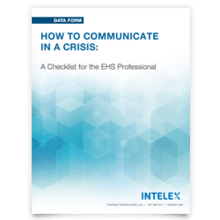It is safe to say that at some point, most of us will face a crisis and it’s improbable that we can eliminate or rid every inherent risk in the workplace. An effective crisis management plan with preparation, along with the clearly defined roles and responsibilities and practical training ensures the best success. An ounce of prevention is surely worth a pound of cure, and for the EHS practitioner, it’s the work at the front end that limits a lot of fixing afterward.
While there are no absolutes in dealing with crisis communications since every organization is different, it’s a safe bet that the EHS practitioner may be called upon to deliver information or will be integral in preparation of any internal or external communication. Why? Because the practitioner is likely the person on the management team who best understands the crisis and the crisis management plan, has knowledge of the incident command structure and already has begun assembling information that will be used by others.
How to Communicate in Crisis: A Checklist for the EHS Professional not only can be used to help you gather and report information, but to anticipate what information will be needed by management, employees, government agencies and your company’s public information officer and what probable next steps can be expected as the event unfolds.
Download it now.
 1 877 932 3747
1 877 932 3747
